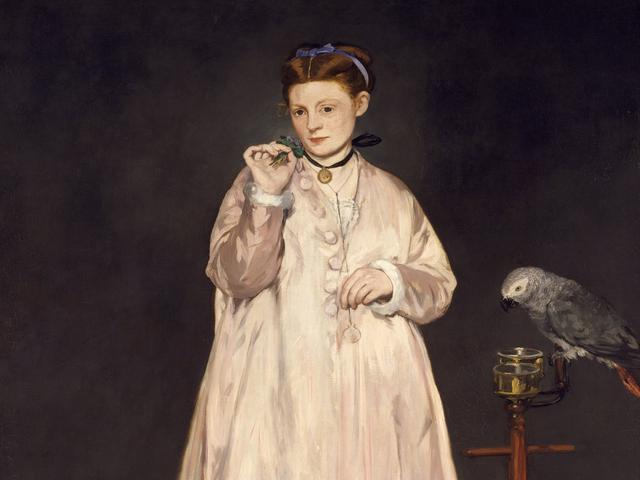Young lady in 1866

Edouard Manet's painting, Young Lady 1866, is a classic realist piece that illuminates the style of the era.
The painting shows a detailed young woman (Manet's traditional muse, Victorine Meurent), accompanied by her gray parrot.
Edouard Manet had described the piece as a "current vice" to "value more than a sneaker." The painting depicts a woman dressed in a loose nude white dress that flows to the floor. The dress has an incredible texture and features different areas of shadow and light. She wears a tight black necklace with a gold medallion in the middle, paired with an innocent purple ribbon inside her hair.
The woman is standing next to her parrot which sits on a brown wooden stick. The parrot is painted with immense texture, enhancing every feature found on the dark gray animal. At the bottom of the stick, falling onto the woman's dress, lies a partially peeled orange. The discarded orange on the ground illuminates a sense of luxury within the painting, as the fruit was rare to obtain and only available to the upper class. The model holds a small blue flower on her nose in her right hand, accompanied by a monocle hanging in her left hand.
Edouard Manet was born in Paris on January 23, 1832, into a wealthy and well-connected family. His mother, Eugenie-Desiree Fournier, was the goddaughter of the Swedish crown prince, Charles Bernadotte, from whom the current Swedish monarchs are descended. His father, Auguste Manet, was a French judge who hoped Edouard would pursue a career in law. His uncle, Charles Fournier, encouraged him to pursue painting and often took the young Manet to the Louvre. In 1845, following his uncle's advice, Manet enrolled in a special drawing course where he met Antonin Proust, future Minister of Fine Arts, and a later lifelong friend.
© Tourblink